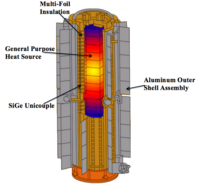Application of silicon-germanium thermoelectrics in space exploration

Alright kiddo, have you ever heard of space exploration? It's when people send rockets and spaceships to go explore space and other planets. But going to space is not an easy job, it's very cold and can be very harmful to humans if they're not protected.
That's where silicon-germanium thermoelectrics come in. This is a big and complicated word, but it's actually about making something that can work as an energy source to keep things warm or cool. They are like a tiny power plant that you can attach to other objects to either heat them up or cool them down.
When we send spaceships into space, we need to be able to control the temperature inside them. If it gets too hot or too cold, it could damage or even destroy the instruments and equipment on board. We can use these silicon-germanium thermoelectrics to help keep everything at the right temperature.
Thermoelectrics work by using temperature differences to create electricity. So the devices have two different materials, one on the hot side and one on the cold side. When there's a temperature difference between the two, an electric current is created. This can be used to power other things on board the spaceship.
Silicon-germanium thermoelectrics are especially useful in space exploration because they can withstand extreme temperatures, including the very cold temperatures of space. They can also be very lightweight and small, making them portable and easy to transport.
So, the bottom line is that these silicon-germanium thermoelectrics are a very important part of space exploration because they help keep the spacecraft and the instruments inside them at the right temperature, and also can help generate electricity to power other things on board.
That's where silicon-germanium thermoelectrics come in. This is a big and complicated word, but it's actually about making something that can work as an energy source to keep things warm or cool. They are like a tiny power plant that you can attach to other objects to either heat them up or cool them down.
When we send spaceships into space, we need to be able to control the temperature inside them. If it gets too hot or too cold, it could damage or even destroy the instruments and equipment on board. We can use these silicon-germanium thermoelectrics to help keep everything at the right temperature.
Thermoelectrics work by using temperature differences to create electricity. So the devices have two different materials, one on the hot side and one on the cold side. When there's a temperature difference between the two, an electric current is created. This can be used to power other things on board the spaceship.
Silicon-germanium thermoelectrics are especially useful in space exploration because they can withstand extreme temperatures, including the very cold temperatures of space. They can also be very lightweight and small, making them portable and easy to transport.
So, the bottom line is that these silicon-germanium thermoelectrics are a very important part of space exploration because they help keep the spacecraft and the instruments inside them at the right temperature, and also can help generate electricity to power other things on board.
Related topics others have asked about:
